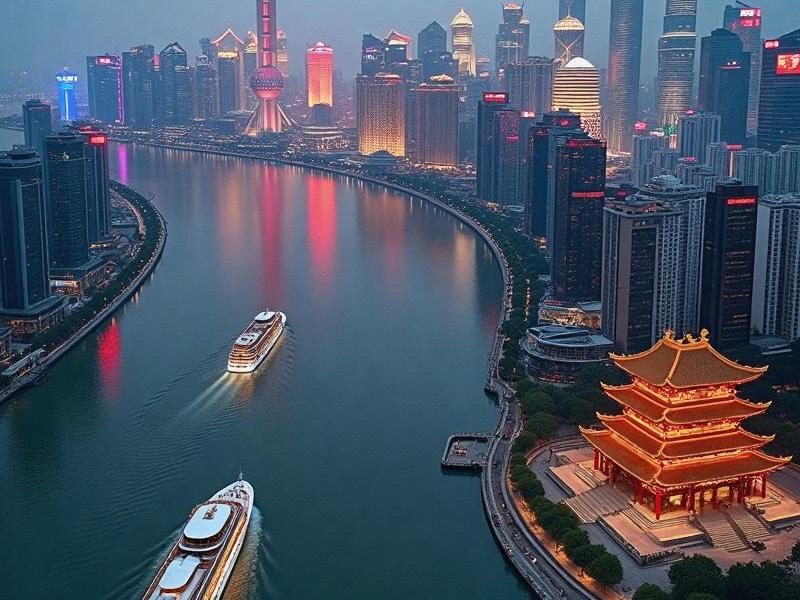Shanghai: The Nexus of Heritage and Progress in the 21st Century
⏱ 2025-05-06 10:01 🔖 阿拉爱上海419
📢0℃

Historical Foundations in a Modern Metropolis
Shanghai's DNA intertwines colonial architecture with futuristic skyscrapers. The Bund's Art Deco facades coexist with the Shanghai Tower's twisting lattice design, housing Asia's largest carbon-neutral district. The city's 16 million residents navigate this blend daily—morning tea in a restored Shikumen house transitions seamlessly to board meetings in glass towers hosting Fortune 500 companies.
Key historical landmarks undergoing revitalization:
- Nanjing Road: Pedestrianization project integrates augmented reality guides recounting 1920s Shanghai
- Yuyuan Garden: AI-powered lighting system illuminates Ming Dynasty rockeries based on weather patterns
- Wukang Road: Time capsule installation preserving 1930s shopfronts with holographic shopkeepers
---
Economic Engine of Innovation
Shanghai drives 28% of China's GDP (National Bureau of Statistics, 2024) through:
- Pudong Financial District: Home to 136 Fortune 500 corporate HQs and the world's second-busiest stock exchange
- Caohejing Science Park: Produces 47% of China's semiconductor chips using AI-driven 3D lithography
- Port of Shanghai: Handles 42 million TEUs annually via automated container terminals powered by quantum computing
The city's innovation ecosystem thrives through:
- Shanghai Tech University: Partnered with CERN on quantum particle accelerator research
- Huangpu River Innovation Corridor: 5G-enabled smart labs hosting 1,200 startups
- Carbon-Neutral Finance Initiative: Blockchain-tracked emissions reductions in real estate transactions
新夜上海论坛 ---
Cultural Renaissance Through Technology
Shanghai reimagines tradition using digital tools:
- Yuyuan Bazaar: Blockchain-authenticated antiques paired with AR craftsmanship demonstrations
- Shanghai Film Studio: AI co-writes scripts blending Peking opera motifs with sci-fi narratives
- Zhujiajiao Water Town: 5G-enabled boat tours reconstructing 14th-century flood defense systems
Annual cultural events showcase this fusion:
- Shanghai Digital Festival: Holographic performances of 1930s Shanghai jazz clubs
- Lunar New Year Tech Parade: Drone formations recreating traditional lion dances in LED light
- Global Heritage Summit: VR reconstructions of pre-colonial Shanghai walls and canals
---
Green Transformation Blueprint
Shanghai leads China's sustainability efforts with:
- Suzhou Creek Revival: 14 km waterfront park converting industrial zones into carbon sinks
- Huangpu River Solar Belt: Floating photovoltaic arrays generating 80 MW on water surfaces
- Vertical Forest Towers: 80-story buildings covered in 45,000 plants absorbing 28 tons CO2/month
夜上海最新论坛
The 2035 Master Plan mandates:
- 70% waste-to-energy conversion in Pudong by 2030
- Underground mushroom farms utilizing metro tunnel heat waste
- AI-managed green corridors connecting urban parks with suburban wetlands
---
Smart Infrastructure Revolution
Shanghai's tech-driven urban planning includes:
- Maglev 2.0: 600 km/h trains using quantum navigation through densely populated areas
- Yangtze River Delta Metro Alliance: Unified QR payment system across 22 cities' transit networks
- Digital Twin City: Quantum simulation managing traffic, energy, and emergency responses
Upcoming projects:
- Shanghai-Kunming Hyperloop: Vacuum tube transport reducing travel time to 6 hours
- Solar-Powered Smart Islands: Caihong Island's microgrid running on offshore wind and algae biofuel
- Underground Farming Network: Vertical agriculture in repurposed subway tunnels
---
上海龙凤419贵族
Challenges of Hyper-Urbanization
Persistent issues demand innovative solutions:
- Water Scarcity: Desalination plants using AI-optimized solar evaporation systems
- Traffic Congestion: Autonomous vehicle corridors prioritizing public transit in smart lanes
- Cultural Erosion: Digital archives preserving 22 endangered Shanghainese dialects
Government responses blend regulation with community engagement:
- "15-Minute City" policy ensuring residential areas have amenities within walking distance
- Resident co-design platforms for urban renewal projects
- Intergenerational knowledge transfer programs pairing seniors with AI developers
---
Future Vision: The World's First Carbon-Negative Megacity
Shanghai's 2050 Master Plan proposes:
- Floating Green Cities: Artificial islands with carbon-sequestering mangrove forests
- Atmospheric Water Harvesters: Atmospheric rivers providing 30% of freshwater needs
- Neural Network Governance: AI-assisted decision-making integrating citizen sentiment analysis
As the Oriental Pearl Tower's LED matrix illuminates the Huangpu, it reflects a city rewriting urbanization's rules—where centuries-old teahouses share alleyways with quantum labs, and every sustainability metric tells a story of human-nature symbiosis. Shanghai's true innovation lies not just in building cities, but in cultivating ecosystems where progress honors heritage.
Shanghai's Renaissance: A Journey Through the City's Modern TransformationShanghai's Entertainment Clubs: A Thriving Nightlife SceneThe Shanghai Spark: How Women Are Redefining China's Global CityShanghai 2045: The Rise of China's Smartest MegacityShanghai's Thriving Entertainment Clubs: A Nightlife RenaissanceSilk & Silicon: The Dual Identity of Shanghai's Modern WomenA Glimpse into the Vibrant Nightlife of Shanghai: An Overview of Shanghai Entertainment VenuesShanghai & Yangtze Delta: The Quantum-Climate Civilization PrototypeA Comprehensive Exploration of Shanghai and Its ProspectsShanghai's Semicircle: A Journey Through the Urban and Rural Divide
Shanghai's Entertainment Clubs: A New Era of Nightlife and Cultural ExchangeShanghai's Nightlife Renaissance: How Luxury Clubs Redefine Urban EntertainmentPhantom of the Bund: How Shanghai's Entertainment Palaces Are Writing the Future of NightlifeSilicon Bund: How Shanghai Became China's Unexpected Tech PowerhouseShanghai's Transformation: A Journey of Urban Renewal and Cultural RenaissanceShanghai's Style Revolution: How Local Women Are Redefining Chinese Beauty StandardsVelvet Ropes & Digital Dreams: Shanghai's Next-Gen Entertainment Palaces Redefine Nightlife LuxuryExploring the Sights and Sounds of Shanghai and Its SurroundingsThe Shanghai Femme: How China's Most Cosmopolitan Women Are Redefining Beauty, Power and CultureShanghai 2030: The Making of a Future-Ready Megacity

